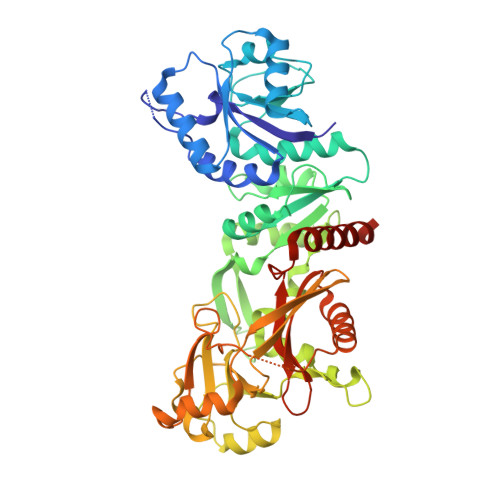Diversification in the inositol tris/tetrakisphosphate kinase (ITPK) family: crystal structure and enzymology of the outlier AtITPK4.
Whitfield, H.L., He, S., Gu, Y., Sprigg, C., Kuo, H.F., Chiou, T.J., Riley, A.M., Potter, B.V.L., Hemmings, A.M., Brearley, C.A.(2023) Biochem J 480: 433-453
- PubMed: 36896917
- DOI: https://doi.org/10.1042/BCJ20220579
- Primary Citation of Related Structures:
7PUP - PubMed Abstract:
Myo-inositol tris/tetrakisphosphate kinases (ITPKs) catalyze diverse phosphotransfer reactions with myo-inositol phosphate and myo-inositol pyrophosphate substrates. However, the lack of structures of nucleotide-coordinated plant ITPKs thwarts a rational understanding of phosphotransfer reactions of the family. Arabidopsis possesses a family of four ITPKs of which two isoforms, ITPK1 and ITPK4, control inositol hexakisphosphate and inositol pyrophosphate levels directly or by provision of precursors. Here, we describe the specificity of Arabidopsis ITPK4 to pairs of enantiomers of diverse inositol polyphosphates and show how substrate specificity differs from Arabidopsis ITPK1. Moreover, we provide a description of the crystal structure of ATP-coordinated AtITPK4 at 2.11 Å resolution that, along with a description of the enantiospecificity of the enzyme, affords a molecular explanation for the diverse phosphotransferase activity of this enzyme. That Arabidopsis ITPK4 has a KM for ATP in the tens of micromolar range, potentially explains how, despite the large-scale abolition of InsP6, InsP7 and InsP8 synthesis in Atitpk4 mutants, Atitpk4 lacks the phosphate starvation responses of Atitpk1 mutants. We further demonstrate that Arabidopsis ITPK4 and its homologues in other plants possess an N-terminal haloacid dehalogenase-like fold not previously described. The structural and enzymological information revealed will guide elucidation of ITPK4 function in diverse physiological contexts, including InsP8-dependent aspects of plant biology.
Organizational Affiliation:
School of Biological Sciences, University of East Anglia, Norwich Research Park, Norwich NR4 7TJ, U.K.















